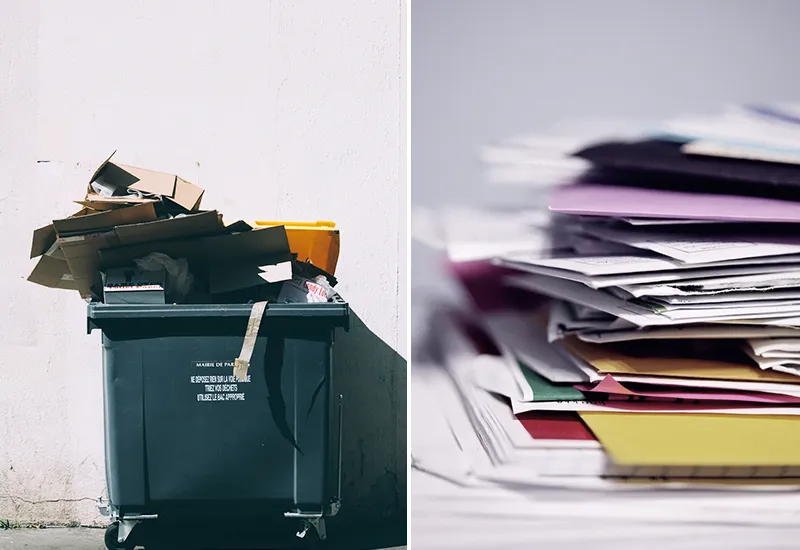Do you want to know how you can save paper in the office and how a paperless office can be realized? Then you've come to the right place! We Germans consume an average of around 227 kilograms of paper per person per year. This requires around 500 kilograms of wood.₁ Most people want to do something about it, but simply don't know where to start.
That can be changed! File folders, printers and photocopiers, flipcharts, notes, dispatch boxes, letters - a large proportion of paper consumption is mainly caused by office work. Fortunately, it can be reduced to a minimum with really simple means.
In this article, I'll show you exactly how you can get started and save paper in your home office or at work. You'll also find out how the switch to a completely paperless Paperless office can be mastered. Let's go!
Here is a brief overview for you in advance:
Advantages: Why should you strive for a paperless office?

It takes around 5.5 kilograms of wood, 130 liters of water and 13 kilowatt hours of energy just to produce 500 sheets of normal copy paper. 833 sheets of paper per month.₃ Disturbing and at the same time motivating facts, right?
Before we move on to the practical tips, I would like to share your motivation for conscious and long-term Save paper now increase immeasurably. What do we gain by reducing paper consumption in the office? The following benefits give us a clear picture of the impact of a possible paperless office.
The main opportunities and advantages
- Environmental friendliness: The paperless office reduces the Deforestation of the forests for paper production and protects valuable ecosystems. In addition, the lower paper consumption conserves natural resources such as wood and water - and also reduces energy requirements.
- Cost savingsBy reducing paper consumption in the office, costs for postage, printers, ink, maintenance and storage capacity can be minimized.
- Independence of location: The paperless office is not bound to place and time. The digitization of documents enables access to important information and data from anywhere. Whether in the home office, on the move or at different company locations.
- EfficiencyDigital documents are easier to search, sort and archive. This facilitates quick access to the information you are looking for and promotes collaboration and productivity. In addition, important connections can be recognized even faster.
- Space savingThe paperless office reduces the need for physical storage of documents, resulting in more efficient use of space.
- Security and complianceDigital documents offer greater data security and are easier to protect than physical documents. They simplify compliance with data protection regulations and are not vulnerable to disasters. (e.g. fire or flooding)
- Improved customer serviceFaster and easier access to information means that customer inquiries can be answered much more quickly and effectively.
- Great external impact: A paperless office is an important Feature of attractive employers:insidemakes every company more interesting on the labor market and not only for this reason more competitive.
10 tips: How can you save paper in the office?

Motivated enough? Great! Then we can now move on to the general tips for saving paper in the office, before moving on to the advice for switching to a paperless office. The following ideas can basically be implemented immediately in any office.
1. use recycled paper
Instead of relying on virgin paper, use recycled paper. Due to the recycling circuit, paper can be easily reused and above all wood as Conserve natural resources. Recycled paper can be used in the office just like new paper - but it is usually cheaper and definitely much more sustainable.
2. weigh up the necessity of the expression
Using recycled paper is a good start for all of us. But of course it does not reduce internal paper consumption. Because the most sustainable expression is the one that is not made in the first place.
Therefore, ask yourself the following questions, among others: Do I really need to print out the e-mail? Do I have to print and copy the whole report or are two pages of the report enough? First think and then print is the motto for reducing paper consumption in the office.
3. print double-sided
Printing on both sides is a great Tip for sustainable printing. After all, the double-sided printout can already save half of your own paper consumption.
Many companies and consumers are aware of this and make double-sided printing the default setting on their devices. They implement these measures in both internal and external communication.
4. set smaller font
By reducing the font size of the respective document before the (unavoidable) printout, you significantly reduce the number of printed pages. Selecting a smaller font is done in seconds. However, make sure it is not too hard to read to avoid misprinting or duplication.
5. print without graphics
Experience has shown that photos and other (often color) graphics are not needed on most printouts. By removing the graphics and printing only the relevant textthe document retains its informative value while saving paper and toner.
6. use paper several times
Used paper should not end up unused in the bin, but should be used as often as possible. There are countless ideas for reuse! Use the free backs of documents, for example, for free designs. Or simply reduce the size of the A4 sheets and turn them into small notepads. Also Shipping boxes can of course be easily stored and used again.
7. master meetings without paper
With the help of digital assistance sustainable meetings completely paperless these days. Instead of presenting information on multiple copied, printed presentations, reports or handouts, you can, for example, simply present them on Screens or per PDF file with your colleagues in the office.
8. introduce paper saving in the office
Many employees and consumers unknowingly use a lot of paper because they have not been sensitized to the problem of paper waste. A company's own "paper savings program" is a great Opportunity to generate attention and stimulate a rethink in the entire team.
It is important to internalize the aforementioned advantages of a paperless office. As part of the challenge, all colleagues in the office work together to identify unnecessary paper products and learn how to replace them with paperless ones.
9. write emails instead of letters
By using your Digitize letter mailyou can make a significant contribution to saving paper in the office - and you also save money through sustainability and a lot of time. This is one of the reasons why the public's acceptance of e-mails is extremely high.
Letters are often sent anyway because they have to be signed. The establishment of a E-signature software or simply a digital signature in the PDF reader, can prevent this printout and, not least, make the dream of a paperless office more tangible.
10. switch to digital alternatives
I basically no longer use paper in my own office because I have digitized (almost) everything. Only my notebook*, which I have been using for several years, serves me faithfully as a paper product.
Otherwise, when paper lands on my desk, it's a Invoice that other companies send me by mail. But even these are becoming fewer and fewer because I either switch to sending them online by email instead of by letter or inform the sender of my request by email. The switch to digital solutions makes the paperless office ultimately made possible.
10 digitization tips: How to make the switch to a paperless office?

Speaking of digitalization! Although we are in the middle of the digital age, we humans still use almost as much paper in our everyday lives as we did in the year 2000.₄ The Switching to a paperless office that is as digitalized as possible is a great opportunity, to really achieve a noticeable, positive impact in this respect.
Depending on the size of the company, however, the process may require a great deal of discipline and courage and may also be lengthy. Whether working from home or in an open-plan office - Simply use the following tips and ideas to make the switch to a paperless office with ease.
1. define actual and target state
First analyze the current paper consumption and Identify the areas where the amount of paperwork is currently still very high.
Then define realistic goals and interim goals and get a picture of what you want to achieve. One clear idea of the desired state helps to effectively manage the changeover process and develop suitable measures.
Remember that goals Specific, measurable, attractive, realistic and scheduled (S.M.A.R.T) should be. In this respect, the so-called SMART formula serves as a useful orientation aid and a clear definition of goals.
"Internal paper consumption in the office will be reduced by 50 percent to an average of 100 sheets of paper per employee by December 31 of this year." - for example, is a nice, practical formulation that all colleagues could use as a guide.
2. create the technical basis and get started
For a digital and paperless office, you first need the right equipment. Modern computers and smartphones with scanning appsand high-quality scanners, for example, belong in every office without paper.
First digitize all documents stored in paper form as PDF documents by scanning them. The amount of work involved is of course very high in most cases - but it's worth it and frees up a huge amount of space. The work also only has to be done once. 😉
3. focus on sustainable document destruction
Private consumers:inside simply dispose of documents that are no longer needed in the blue paper garbage can. This ensures that the Natural resources can be recycled and reused as recycled paper in the office, for example.
However, companies have to comply with retention periods of sometimes more than ten years for certain documents and records, meaning that large quantities of paper accumulate. In such cases, it is advisable to rely on sSpecialized waste management companies certified by TÜV to set the course for sustainable Document destruction have dedicated.
You dispose of paper waste in a targeted manner and are able, for example, to destroy the files on site by truck to save countless company transport trips. An important measure in preparation for a permanently paperless office.
4. create meaningful file names and folder structures
A well-organized, logical file and folder structure is the backbone of an efficient paperless office. Assign meaningful, descriptive file names and create a clear, unambiguous folder structure that allows enables all employees to find the documents they need quickly and easily - and, conversely, to file them sensibly. Digital software can make document management much more secure and easier.
5. save files to the cloud
After you have digitized all the documents, it's time to create a centralized Find a storage location so that files are accessible to every colleague and are not stored on individual computers.
Documents and other files can be easily stored digitally in internal cloud storage. They enable all employees to More flexibilityas the data can be accessed from anywhere with any internet-enabled device. However, ensure the appropriate IT Security - for example, by setting up two-factor authentication.
6. digitize accounting
Experience has shown that a particularly large amount of paper is used in accounting. Invoices, sales lists, supporting documents and other records pile up - not least because of the long retention periods.
Fortunately, nowadays there are many good software and programs that do exactly this "paperwork" for you. I write my invoices with a simple Invoicing softwareThey are also automatically filed in the system - reminders are also sent out automatically by e-mail as soon as the payment deadline has been reached.
In addition, the monitoring of sales by the Online banking has long been possible digitally. Switching over at your bank will ultimately save you thousands of folders of account statements. Banking matters can then also be easily managed from anywhere.
7. use a digital calendar
Digital diaries are making even sticky notes increasingly superfluous. You can set appointments both on your PC or smartphone and also with special apps or software tools and ensure that all or only certain colleagues have access to it. Push notifications keep you informed of current appointments on time - so you'll never miss an appointment again. Pretty handy, isn't it?
8. use helpful apps and tools
Cloud-based software, such as the Digital Asset Management (DAM)are a real stepping stone to the digitization of companies, as all relevant business documents can be stored and retrieved there.
However, many smaller tools can also help significantly in getting closer to a paperless office. Here are a few examples:
- Google Drive: A file hosting service where the team can access and (even collaboratively) edit files live.
- Signeasy: An eSignature platform to simplify and automate document workflows.
- Evernote: To create digital to-do lists, edit files, send them as e-mail and share them with other users.
- Scanner Pro: With smartphone apps like these, any paper document can be scanned in seconds and uploaded to cloud storage.
- …
Do you know of any other tools to save paper in the office? Then I look forward to your ideas in the comments column!
9. digitize internal communication
The digitalization of internal communication is an extremely important step towards reducing paper consumption in the office. Emails, instant messaging apps, specialized project management software and other digital communication tools facilitate the exchange of information and greatly reduce the need for physical documents. They also encourage the entire team to works much more productively and stress-free.
10. create guidelines for the paperless office
Clear specifications and guidelines simplify the long-term environmentally conscious handling of paper and digital documents in the office. The paperless office should be a valuable and always communicated part of the sustainable corporate philosophy be
It is advisable to ensure that all employees are pulling in the same direction and that the new colleagues are also aware of this, Regular training courses to be carried out. The main aim was to promote IT skills so that the entire team can take full advantage of the opportunities to save paper using digital tools.
Paperless office and saving paper at work? No problem!

If you know how to do it and where to start, saving paper in the office is easy. really easy as pie. If you simply cannot avoid printing, use recycled paper, for example, print on both sides with a smaller font size and use printouts that are no longer needed as notepads.
Digital devices and tools in particular will ultimately enable us to achieve the paperless office we are striving for. Define a clear goal and start by digitizing accounting and internal communication, for example. Also make sure that all colleagues in the team are committed to the common goal of a paperless office.
"The world changes by your example, not by your opinion."
Paulo Coelho (more at Environmental protection quotes)
I very much hope that I have been able to help you with these tips for reducing paper consumption and making your office as paperless as possible. Do you have any questions, suggestions or further tips? Then I look forward to your comment.
Stay sustainable and conserve resources,

PS: Less paper at work usually also means that our eyes are exposed to flickering screens more often than usual. How to optimize your Permanently save your eyes on the computerI'll explain in the next blog article.
References:
₁ WWF Germany: Turning forests into paper (as at: 10.11.2021), available at https://www.wwf.de/themen-projekte/waelder/papierverbrauch/zahlen-und-fakten. [12.06.2023].
₂ J. Trauth, E. Schönheit (2016): Paper Compass, 16th edition, Forum Ökologie & Papier, August 2016, p.4.
₃ P. Liegl: Interesting facts about the paperless office (as at: 26.4.2023), available at https://ecosio.com/de/blog/interessante-fakten-zum-papierlosen-buero. [12.06.2023].
₄ NABU: Paper consumption in Germany Less writing paper and more packaging, available at https://www.nabu.de/umwelt-und-ressourcen/ressourcenschonung/papier/30377.html. [12.06.2023].









